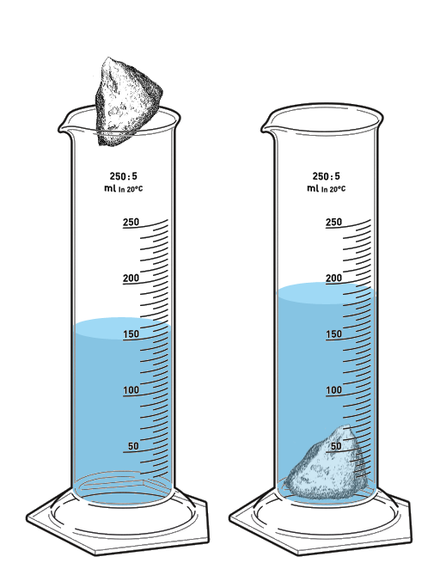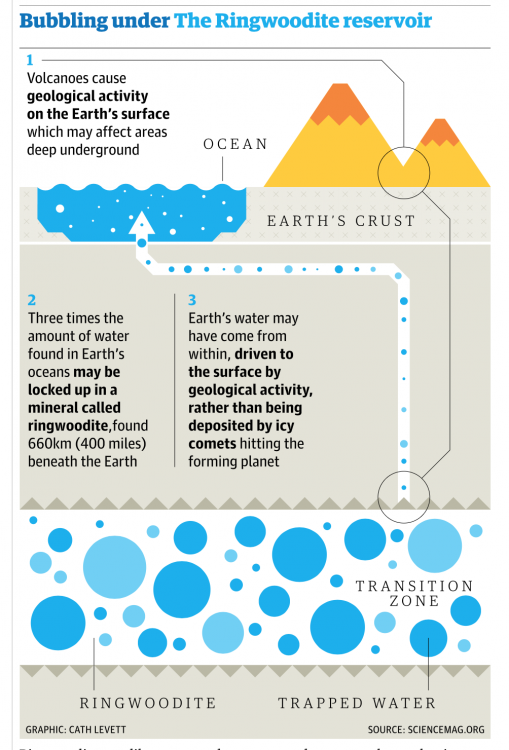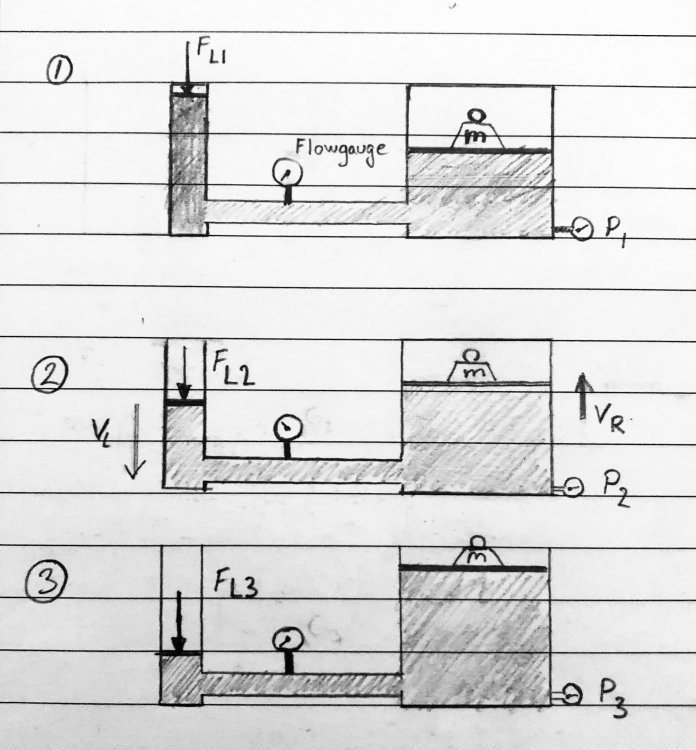-
Posts
2616 -
Joined
-
Days Won
21
Content Type
Profiles
Forums
Events
Everything posted by Ghideon
-

Gravity is limited to a range extendable with the speed of light c
Ghideon replied to awaterpon's topic in Speculations
I suppose the above comment is in addition to the initial one statement below; it applies to coulomb's law? Which means per your idea that beyond a certain range magnetic fields and electrical fields suddenly must drop to zero? Can you provide references or evidence? -
What is this trying to prove? Some kind of luminiferous ether theory?
-
Mass per unit volume is known as density, often denoted by letter [math]\rho[/math]. Mass, density and volume is related: [math]\rho=\frac{m}{V}[/math]. Since copper has [math]\rho=8930 kg/m^{3}[/math] that equals [math]\rho=8.930 kg/dm^{3}[/math]. Note that [math]1dm^{3}=1Liter[/math]. So, given the mass of copper you should be able to calculate the volume of copper which equals the volume of water that is displaced. Note that Solid or liquid does not matter, the concept of volume is the same. Here is a picture of measurement of volume by displacement. The amount by which the liquid rises in the cylinder is equal to the volume of the solid rock. (wikipedia/Displacement_(fluid) )
-
That number doesn't seem quite right. Compare a volume of 45.48 liters of solid copper with the mass you calculated, what does that show? You might need to show the calculations you have done so far, that would allow for better hints about how to proceed.
-
Next hint: what volume of a piece of copper would have that specific mass? Could that volume help you find out how much water that is displaced? Note; I'm assuming a solid piece of copper, not a hollow sphere or similar. (You might want to check the rounding of the intermediate steps depending on the precision required in the final answer)
-
Let's try this hint, in the form of a question: What mass would make the scale show 380 N?
-
Yes, calculating the volume of the piece of copper is a good start!
-
As far as I know it is ok to post an answer ones own question in homework section, but it might be best to consult the rules first.
-
Ok! If you try to use the numbers in the task in the buoyant force formula, what does it look like? It might help to take a look at the units.
-
I think you would have to show evidence that the device actually have the effects you claim before presenting further ideas based on that device.
-

Standing waves (Split from EM waves with astronomical wavelength)
Ghideon replied to RayTomes's topic in Speculations
Not necessarily, but at least enough to understand what the idea is. Initial question: and Why are distances of galactic cluster walls connected to geological cycles? What evidence exists for that claim? -
Initial questions to start a discussion: -Have you solved similar problems where solids are (partially) submerged in water? -Are you familiar with Archimedes' principle? It might also help to draw a picture.
-

Gravity is limited to a range extendable with the speed of light c
Ghideon replied to awaterpon's topic in Speculations
Gravitational waves are disturbances in the curvature (fabric) of spacetime, generated by accelerated masses, that propagate as waves outward from their source at the speed of light. https://en.wikipedia.org/wiki/Gravitational_wave -

Standing waves (Split from EM waves with astronomical wavelength)
Ghideon replied to RayTomes's topic in Speculations
I got curious and checked the second link. In the beginning it states Paper Presented by Ray Tomes to Natural Philosophy Alliance. Natural Philosophy Alliance on google takes me to (https://wiki.naturalphilosophy.org/index.php?title=Natural_Philosophy_Alliance) That wiki also says: Maybe it's better to present the evidence here, how the theory makes far more successful predictions than Big Bang theory. -

Gravity is limited to a range extendable with the speed of light c
Ghideon replied to awaterpon's topic in Speculations
I did not manage to understand all of the descriptions, but some of it sounds like some variant of Zeno's paradoxes; wikipedia.org/Zeno's_paradoxes/Achilles_and_the_tortoise Are you suggesting that due to limitations in formal treatments of the mathematics* it must follow that gravity physically must drop to zero at some distance? When I apply (my rather limited) skill I do not see the issues with the formulas. Also; is this some kind of general law you are suggesting? There are other equations that are dependant of range, for instance Coulomb’s Law. *) for limits, infinity, real numbers and other concepts in OP -
Good idea, got me thinking. I would probably start by looking into research on Water in Earth's mantle and maybe extrapolate or make up something "plausible-sounding" scenario. By "plausible" I mean something that sounds reasonable to the audience of the fictional writing. Here is a picture from theguardian.com that might illustrate what I mean: Important note: I haven't checked the sources for scientific correctness, my intention at this time is only to post something that might inspire something fictional.
-

The Graviton was found the holy grail of physics
Ghideon replied to Phantom5's topic in Speculations
Welcome to speculations, where one may also boldly go where no man has gone before. But please provide some kind of model and math describing what you want to discuss. My version of the universal translator seems incapable of translating the post to Federation Standard English. -

Reactionless device using the principle of Pascal for fluids
Ghideon replied to esposcar's topic in Speculations
The issues can be put into two groups and may be discussed separately. First part: I already* applied your math and your assumptions in earlier posts and highlighted the issues. May i suggest that you address those issues now? They shows that the equations and/or basic assumptions are wrong. Since those issues and equations are independent of how the cylinders works internally, as described in my analysis, you can provide answers without going into hydraulics and flow fluids. Second: Thanks for the response. Since we agree that fluid moves through the system, how come the equations presented in the idea* fails to take this important fact into account? I'll make some additional drawings hopefully later today, if necessary. *) link for convenience comment-1098947 **) every presented version of the idea, as far as I can tell -

Gravity (Split from Exact scientific definition of weight)
Ghideon replied to ja7tdo's topic in Speculations
(One of several issues highlighted, bold by me) Have you seen impact craters? (I'll suggest this post being moved to an appropriate place) -

Reactionless device using the principle of Pascal for fluids
Ghideon replied to esposcar's topic in Speculations
Here is an attempt at showing some basic flow of fluid in hydraulics. Two pistons with different area in a simplified setup, connected via a thinner pipe. Somewhere along the pipe there is a flow gauge. In the right piston there is a pressure gauge*. There are three scenarios**. The first scenario is stationary. In the second scenario enough force is used so that the mass m is moving vertically at constant speed. The third scenario is again stationary. Any fluid is flowing from left to right cylinder is passing the flow gauge. In scenario 1 and 3 the registered flow will be zero, forces balances the mass m. The gauge will register a flow > 0 in scenario 2. @esposcar: according to you there is no flow of fluid in scenario 2, the gauge should register no fluid passing, how is that possible? *) Not yet used, added for later use depending on answers. **) I try to not include unnecessary details at this point, such details include, but are not limited to: Between 1 and 2 (and also between 2 and 3) there's acceleration of the mass m. Forces F are not equal. Pressures P are not equal. Mass of fluid os not shown. -

Reactionless device using the principle of Pascal for fluids
Ghideon replied to esposcar's topic in Speculations
When the excavator piston is extended, how do you think the hydraulic oils is moved inside the system? Teleportation? How about addressing the issues I've already told you about? -

Reactionless device using the principle of Pascal for fluids
Ghideon replied to esposcar's topic in Speculations
By now several different* issues highlighted, I have tried to use both logic and some Math. May i suggest that you address those issues before asking for more issues to be pointed out? Note my earlier comments, the device can not work as described and there are issues independent of how the cylinders works internally. Sorry, my bad, I used a small quote from the page and included a link as reference. My intention was not to suggest that all content or pictures on the page was of good quality. I should probably have used another source in this case or checked the whole page for quality issues before referencing it, I did not intend that other parts of the page should be used. Sorry @studiot for confusing the discussion. Including the obvious one that reactionless device is not possible, regardless of how it is constructed. -

Reactionless device using the principle of Pascal for fluids
Ghideon replied to esposcar's topic in Speculations
One* issue is missing the mass on top of each cylinder when calculating acceleration on each side. Those masses are accelerated upwards then pistons are moving. I repeat: remove the numbers and use symbols. *) There are many more issues ...




